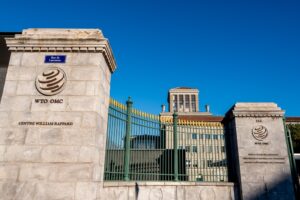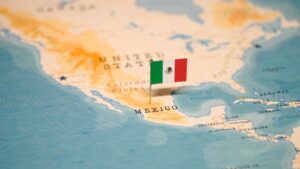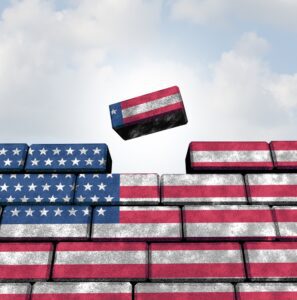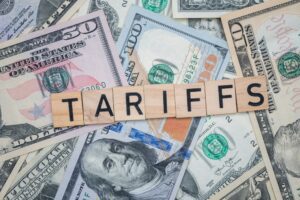In Search of a Clearer Tune: Understanding America’s Frustration with the WTO

The following is an excerpt from an article by Maria Pagan, the former U.S. Ambassador to the WTO. Read more here.
There are a few other areas where the rules-based multilateral trading system – or more specifically, its denizens – falls short.
First, a word on tariff liberalization. Up until very recently, the United States has kept a very open economy with very low tariffs. In addition, the United States has very little water in its tariff bindings, meaning the difference between the tariff levels it commits to at the WTO and its actual applied tariff. For the most part, U.S. bound tariffs are its applied tariffs. That is not the case for many other WTO members. Tariff negotiations are always seen as a two-way street. But the United States does not have much more tariff water to give except in sensitive sectors. Conversely, other members do. So it does not take much to see, perhaps, the roots of the United States’ frustration with the system it built and the concessions it offered to other members of such a system.
Next, there is transparency. There is nothing more basic than providing transparency about one’s trading system. And here, the United States is, if not the best, certainly among the best. And one must understand that transparency makes it easier for others to sue the discloser. You can’t monitor, assess, and sue others if you can’t even find the most basic information about what they are doing. This is an issue with many WTO members, but in particular with China. This is an area where the rules simply don’t apply in the same way to all members.
We welcomed China into the WTO in 2001 with faith and hope that, over time, its non-market economy would become more like the open market models upon which WTO rules are based. That did not happen. And we have found that rules that were created with market economies in mind simply do not apply in the same way to non-market, non-transparent economies. Is it fair to complain that you are retreating from international rules and norms if those rules and norms are incapable of addressing the very clear negative consequences of the Chinese economy and of its failure to follow through on moving toward becoming a market economy?
Read the Full Article Here
05/27/2025| Maria Pagan | Hinrich Foundation
Mexico – From A Short Nearshoring Boom To US “Security-Shoring”

The following is an excerpt from Günther Maihold’s comment, Mexico – From A Short Nearshoring Boom To US “Security-Shoring”. Read more here.
From “friendshoring” to “security-shoring”
The Biden administration had framed its concept of geopolitical reordering under the motto of “friendshoring”. It recommended shifting supply chains away from China towards trusted countries. This was intended to continue ensuring free market access and reduce risks to the US economy as well as to closely aligned trading partners. By highlighting certain partners such as Mexico – due to their identification with US values – the concept of nearshoring was imbued with a strong normative dimension. This became evident as early as 2022, when the Biden administration launched its competition with China through three legislative measures: the Inflation Reduction Act, the CHIPS Act, and the Infrastructure Investment and Jobs Act. These measures initially focused on four global value chains: semiconductors, large batteries, critical minerals and metals, as well as pharmaceuticals and pharmaceutical chemicals.
Now, the second Trump administration has taken a more aggressive approach to supply chain policy, subordinating the United States’ international relations with China to its own national security and domestic political interests. Nearshoring is thus losing its distinction as a seemingly neutral strategy for relocating production from Asia to Mexico; instead, Washington has placed national security interests above all else in its dealings with China. As a result, Mexico runs the risk of being caught between the grinding stones of the two great powers in its economic relations.
Mexican economist Enrique Dussel Peters therefore recommends using the term “security-shoring” to describe the strategy being practiced by the United States. This, he argues, better reflects the fact that Washington is pursuing its interests against China using a wide array of tools and measures. The systemic rivalry and confrontation between the United States and China mean that third countries must adopt specific measures to comply with growing US pressure to follow its lead. Third countries and regional blocs are thus being drawn into the specific measures that Washington is proposing – such as in the areas of trade and FDI – according to US national security considerations, without being to exercise their own strategic options.
Read the Full Comment Here
05/27/2025 | Günther Maihold | Stiftung Wissenschaft und Politik
Trade Under Blockade

President Donald Trump threw the world trading system into disarray with his “Liberation Day” announcement on April 2, 2025. The principles behind the General Agreement on Tariffs and Trade of 1947, where 23 nations agreed to minimize barriers to trade, were abandoned. In its place was a system of baseline tariffs and “reciprocal tariffs” (purported to reflect the level of tariffs, non-tariff barriers, and “cheating” by other nations against American exports) on goods entering the United States.
At time of writing, the full effects of this revolution have not been seen. The reciprocal tariffs were paused, and a series of “deals” and exemptions were in the process of being worked through. However, the nation’s negotiated trade agreements with other nations, and its obligations under the World Trade Organization, were ripped up. Conventional trade economics suggests that Americans will see higher prices and fewer choices, businesses will go under, and jobs will be lost.
The rationale behind the announcement is unclear and appears to vary day to day. Sometimes it is claimed that tariff revenue will make us rich and enable us to replace the income tax. Other times, the motivation appears to be the reshoring of manufacturing, either strengthening the defense industrial base or providing the middle class with jobs that pay enough for only one parent to have to work. On other occasions, it is claimed that the threat of tariffs will be enough to get other countries to lower their trade barriers.
Mainstream trade economics suggests none of this will happen as advertised. Revenue will provide only a fraction of what is needed to support the modern welfare state (which is not under threat). Reshoring manufacturing may happen, but at the expense of better opportunities. With many thousands of manufacturing job vacancies, it is unclear who is clamoring for the return of lower-skilled manufacturing jobs. And so far, the threat of tariffs has been met with reprisal rather than negotiation; other nations are not going to surrender unilaterally.
Throughout the period of modern trade uncertainty, the Competitive Enterprise Institute has warned of these likely adverse consequences. To this point, our analysis has been proven sound. The steel and aluminum tariffs of the first Trump administration, for instance, resulted in higher prices and job losses in ancillary industries. Retaliatory tariffs on US agricultural exports required bailouts for farmers, and so on.
Read the Full Study Here
05/27/2025 | Iain Murray, Kent Lassman & Ryan Young | Competitive Enterprise Institute
Despite the Courts’ IEEPA Rulings, the Tariff Costs Are Still Worse Than You Think

Editor’s note: We were preparing to highlight NFTC President Jake Colvin’s recent op-ed for the Council on Foreign Relations, “The Tariff Costs Are Worse Than You Think,” when two federal courts struck down the President’s use of the International Emergency Economic Powers Act to impose tariffs on goods from nearly every country, and a federal appeals court temporarily stayed the ruling. In the aftermath of the court rulings, we asked Jake to explain why he believes “the tariffs are (still) worse than you think.”
While the Courts’ rulings are welcome, even a successful challenge to the President’s use of IEEPA tariffs would offer only partial relief to American businesses and consumers. For one, the Administration is already utilizing a host of other authorities to impose tariffs and could expand those efforts to achieve a universal baseline tariff. Their broad use of Section 232 authorities to impose duties on steel, aluminum and derivative products could potentially see tariffs applied to everything from furniture to advanced electronics to cough syrup if the Administration presses ahead with new investigations on medicines, lumber, semiconductors and other sectors.
In the short term, as the appeals process plays out and the Administration contemplates its next steps, the courts’ rulings threaten to increase uncertainty, which has real costs for business. Meanwhile, companies continue to contend with new costs of doing business from tariffs and other recent trade policy changes. New requirements compel companies to report the weight, value, and provenance of steel and aluminum in downstream products and, in other cases, identify multiple Harmonized Tariff Schedule classification codes for a single import. Restrictions on trade facilitation policies like de minimis and duty drawback will result in added costs for companies and slow supply chains.
With the “Liberation Day” tariffs in flux, the Administration has a unique chance to focus attention on addressing other countries’ trade barriers in exchange for offering them relief from existing and future U.S. tariffs – including sectoral tariffs. The promise of certainty ought to be a compelling reason for America’s trading partners to strike deals. If the Trump Administration fails to double-down on its dealmaking, the tariff costs will still be worse than you think.
Read the Full Article Here
05/29/2025 | Jake Colvin | Council on Foreign Relations
WITA – We put the community in trade community.
Information about upcoming WITA and trade community events


